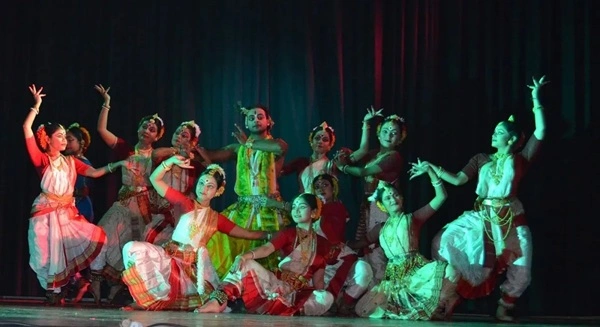West Bengal, often called the “Cultural Capital of India”, is renowned for its rich heritage of literature, music, art, and performing traditions. Beyond Rabindra Sangeet and Durga Puja celebrations, the state is equally vibrant in its folk and traditional dance forms. Rooted in tribal rituals, religious practices, and rural celebrations, these dances narrate stories of mythology, nature, harvests, and social life.
Whether it is the masked martial Chhau of Purulia, the devotional Baul performances, or the energetic Gambhira during Chaitra festival, every dance reflects the diverse ethnic communities and cultural depth of West Bengal.
Major Traditional and Folk Dances of West Bengal

| Dance Name | Type | Region / Community | Short Description |
| Chhau Dance | Martial / Folk | Purulia | Masked dance depicting mythological stories with acrobatic moves. |
| Gambhira | Devotional / Folk | Malda | Performed during Chaitra festival; devotional songs and group dances. |
| Baul Dance | Devotional / Mystic | Birbhum, Nadia | Associated with Baul singers; emphasizes spirituality and mysticism. |
| Santhal Dance | Tribal / Folk | Santhal Tribe (Birbhum, Purulia) | Energetic tribal dance celebrating harvests and nature. |
| Jhumur Dance | Folk | Rarh region (Purulia, Bankura) | Popular among tribal women; performed in circles with rhythmic steps. |
| Natua Dance | Martial / Folk | Rural Bengal | Acrobatic dance showcasing strength, agility, and entertainment. |
| Domni Dance | Folk Drama | Malda, Murshidabad | Semi-theatrical dance with songs and dialogues. |
| Alkap Dance | Rural Folk | Murshidabad, Birbhum | Performed in groups; combines satire, folk tales, and dance. |
| Kirtan Dance | Devotional | Nadia, Mayapur | Performed as part of Vaishnav devotional singing. |
| Raibenshe | Martial / Folk | Rural Bengal | Martial dance with sticks and vigorous body movements. |
Detailed Explanation of Major Dances
- Chhau Dance – The Masked Martial Art of Purulia
- Origin: Emerged in Purulia district; blends martial traditions with folk storytelling.
- Cultural Significance: Depicts episodes from Ramayana, Mahabharata, and Puranas, focusing on valor and spirituality.
- Costumes: Bright and elaborate masks, colorful costumes, and ornamental headgear.
- Musical Instruments: Dhol, dhamsa, shehnai, and nagara.
- Occasions: Performed during Chaitra Parva, festivals, and cultural events.
- Image Suggestion: Purulia Chhau dancers in vibrant masks enacting a mythological battle scene.
- Gambhira Dance – Devotional Folk Expression
- Origin: Malda district; associated with the Chaitra festival.
- Cultural Significance: Focuses on dialogues between man and deity; often includes social and political satire.
- Costumes: Simple dhotis for men, with symbolic props.
- Musical Instruments: Harmonium, dholak, kartal, and flute.
- Occasions: Chaitra Sankranti celebrations and temple festivals.
- Image Suggestion: Gambhira performers in a village stage setup with folk instruments.
- Baul Dance – Mystical Spiritual Expression
- Origin: Rooted in Baul tradition of Birbhum and Nadia.
- Cultural Significance: Represents the philosophy of love, freedom, and devotion; deeply spiritual.
- Costumes: Saffron robes, long flowing garments, and turbans.
- Musical Instruments: Ektara, dotara, duggi, and khamak.
- Occasions: Performed at Baul Melas, fairs, and devotional gatherings.
- Image Suggestion: Baul singer-dancers with ektara under a banyan tree at a rural fair.
- Santhal Dance – Tribal Celebration of Nature
- Origin: Santhal tribe communities of Birbhum, Purulia, and Bankura.
- Cultural Significance: Performed during harvests and Sohrai festival; celebrates fertility and prosperity.
- Costumes: Women wear red-bordered sarees with tribal ornaments; men use turbans and drums.
- Musical Instruments: Dhol, tumdak, and flute.
- Occasions: Harvest festivals, marriages, and tribal fairs.
- Image Suggestion: Santhal women in red-bordered sarees dancing in circles with drummers.
- Jhumur Dance – Rural Women’s Folk Dance
- Origin: Popular in Rarh region (Purulia, Bankura, Bardhaman).
- Cultural Significance: Performed by young tribal women in circles with graceful hand movements.
- Costumes: Colorful sarees, flowers, and jewelry.
- Musical Instruments: Dhol, flute, and cymbals.
- Occasions: Agricultural festivals, fairs, and marriages.
- Image Suggestion: Tribal women in traditional attire dancing in circular formations.
- Natua Dance – Acrobatics and Folk Performance
- Origin: Rural Bengal, connected to village fairs and martial traditions.
- Cultural Significance: Entertainment-based; emphasizes strength, agility, and acrobatics.
- Costumes: Simple dhotis, turbans, and painted faces.
- Musical Instruments: Drums, nagara, and folk instruments.
- Occasions: Village fairs, festive gatherings.
- Image Suggestion: Male performers mid-air while doing acrobatic dance movements.
- Domni Dance – Folk Theatre Dance
- Origin: Malda and Murshidabad districts.
- Cultural Significance: A folk drama combining songs, dialogues, and dance, often satirical.
- Costumes: Colorful attire, symbolic props, and stage decorations.
- Musical Instruments: Harmonium, tabla, and dholak.
- Occasions: Performed in village theatres and seasonal festivals.
- Image Suggestion: Group of Domni artists performing under a temporary village stage.
- Alkap Dance – Satirical Rural Performance
- Origin: Birbhum and Murshidabad regions.
- Cultural Significance: Combines dance, drama, satire, and folk tales; usually performed in open grounds.
- Costumes: Rural costumes with artistic headgear and props.
- Musical Instruments: Dholak, flute, kartal, and harmonium.
- Occasions: Harvest festivals, village fairs, and rural gatherings.
- Image Suggestion: Open-air Alkap troupe performing before villagers.
- Kirtan Dance – Devotional Vaishnav Tradition
- Origin: Nadia and Mayapur (Gaudiya Vaishnav movement).
- Cultural Significance: Associated with Chaitanya Mahaprabhu, performed during devotional singing.
- Costumes: White dhotis, saffron robes, tilak marks.
- Musical Instruments: Mridanga, kartal, and harmonium.
- Occasions: Vaishnav festivals, temple gatherings, and Rath Yatra.
- Image Suggestion: Devotees dancing in Kirtan procession with mridanga and kartal.
- Raibenshe Dance – Martial Stick Dance
- Origin: Rural Bengal, martial folk tradition.
- Cultural Significance: Performed by men with sticks; emphasizes valor and discipline.
- Costumes: Dhoti, turban, and body paint.
- Musical Instruments: Dhol, nagara, and cymbals.
- Occasions: Village gatherings, fairs, and traditional celebrations.
- Image Suggestion: Group of male dancers performing Raibenshe with sticks in hand.
FAQs
Q1. Which is the most famous dance of West Bengal?
👉 The Purulia Chhau Dance is the most famous, known for its masked martial style and mythological depictions.
Q2. How many folk dances does West Bengal have?
👉 West Bengal has more than 10 major folk dances, including Chhau, Gambhira, Jhumur, Santhal, Baul, and Raibenshe.
Q3. Are West Bengal’s folk dances only tribal?
👉 No, the state has a mix of tribal, rural, devotional, and martial dances, each with unique cultural origins.
Q4. Which festivals feature these dances?
👉 Major festivals include Chaitra Sankranti, Durga Puja, Sohrai, and local fairs where dances like Gambhira, Chhau, and Jhumur are performed.
Conclusion
The traditional and folk dances of West Bengal capture the soul of rural life, tribal traditions, spiritual devotion, and martial valor. From the energetic Santhal dance to the mystical Baul performances, and the acrobatic Chhau of Purulia, these dances reflect the state’s cultural richness and diversity.
They are not just performances but also living traditions that continue to bind communities, preserve oral histories, and celebrate West Bengal’s identity as a cultural powerhouse of India.

Hello, I’m Kapil Kumar, a seasoned SEO expert and blogger at WinnersList.in. My mission is to spotlight exceptional individuals and organizations across various domains. Through curated lists, profiles, and inspiring stories, I aim to celebrate outstanding achievements and inspire the next generation of champions. Join me in this journey.
